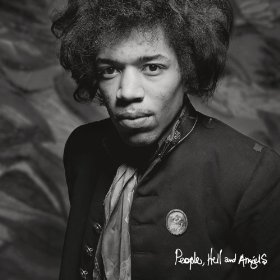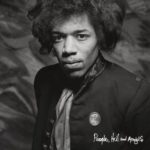
Experience Hendrix LLC/Legacy Recordings
Even hardcore skeptics of Jimi Hendrix’ posthumous catalog will have to admit: People, Hell and Angels contains some damn fine music. Scanning the track list won’t do it: there are a number of these tunes that have appeared on past releases (official and otherwise) but the versions offered here are about as pure Jimi as you’re going to get. With Hendrix’ original studio compadre Eddie Kramer behind the board, People, Hell and Angels offers up the original versions of tunes such as “Crash Landing” (rather than the notorious 1975 project shamefully overdubbed by studio musicians after Jimi’s death). There isn’t a lot of studio whiz-bangery on these tracks: Kramer has worked with what Hendrix laid down to make his presentations. If Jimi pumped his Strat through a Leslie speaker (“Inside Out”) back in 1968, cool – that’s here. But there are no rainbow-colored envelopes on manipulated sound folding in on themselves; no layer-upon-layers of backwards-and-forwards riffs and rhythms churning and chuffing against each other. The worst you could say about some of the cuts offered up on People, Hell and Angels is that they sound stripped-to-the-bone.
But it’s Jimi Hendrix, people. Two hands and six strings without a lot of gadgetry between them and the amp (and between the amp and the tape) still produced sounds that generations of pickers have struggled to replicate. “Stripped-to-the-bone” simply makes for an uncluttered view of a master at work.
“Earth Blues” kicks things off with Hendrix backed by bassist Billy Cox and drummer Buddy Miles, cranking on the funk. The Hendrix/Cox/Miles trio is featured on a number of the tunes here: their fierce take of “Hear My Train A Comin’” is a demonstration in no-overdubs power trio blues; the first twenty seconds or so of the slow-burning “Bleeding Heart” are just Jimi establishing the groove (listen for his yelps of approval as Cox and Miles latch on); and “Villanova Junction Blues” is a short-but-sweet glimpse into Hendrix’ ability to blend lead and rhythm into a single sound: guitar.
“Inside Out” offers a sample of Jimi’s bass playing, applying his own underpinnings to a guitar/drum duet between himself and Mitch Mitchell. “Somewhere” is another example of guitar-hero-as-bassist with Stephen Stills providing some slinky, syrupy bawoomp behind Hendrix and Buddy Miles. “Izabella” features the percussion-heavy Gypsy Sun & Rainbows lineup from Woodstock with Larry Lee providing some tasteful sound reinforcement on rhythm guitar behind Jimi. (The line-up is also represented by the jazzy instrumental “Easy Blues”.)
At first listen, the wide-open, driving R&B jam “Let Me Move You” might seem out of place on this album, but what you’re getting is a peek at Jimi revisiting his roots. That’s saxman/vocalist Lonnie Youngblood leading the way on this one – an old friend of Hendrix’ from his pre-Experience sideman days. Youngblood’s wild-ass vocal and powerful sax playing provide the perfect backboard for Hendrix to bounce his soulman guitar chops off of – which he does for close to 7 minutes. You can hear the grins loud and clear.
Same with “Mojo Man” – Hendrix is having some fun here, bobbing and weaving with the Muscle Shoals rhythm section on a base track recorded by old chitlin’ circuit bud Albert Allen. This isn’t “Third Stone From The Sun” territory – this is just some fine, fine picking.
The bottom line is this: Jimi Hendrix has been dead for over 42 years.
The uncluttered versions of the music on People, Hell and Angels proves that, a couple generations down the line, the man still sets the standard for rock ‘n’ roll guitar.
***
Brian Robbins bobs and weaves over at www.brian-robbins.com



No Comments comments associated with this post